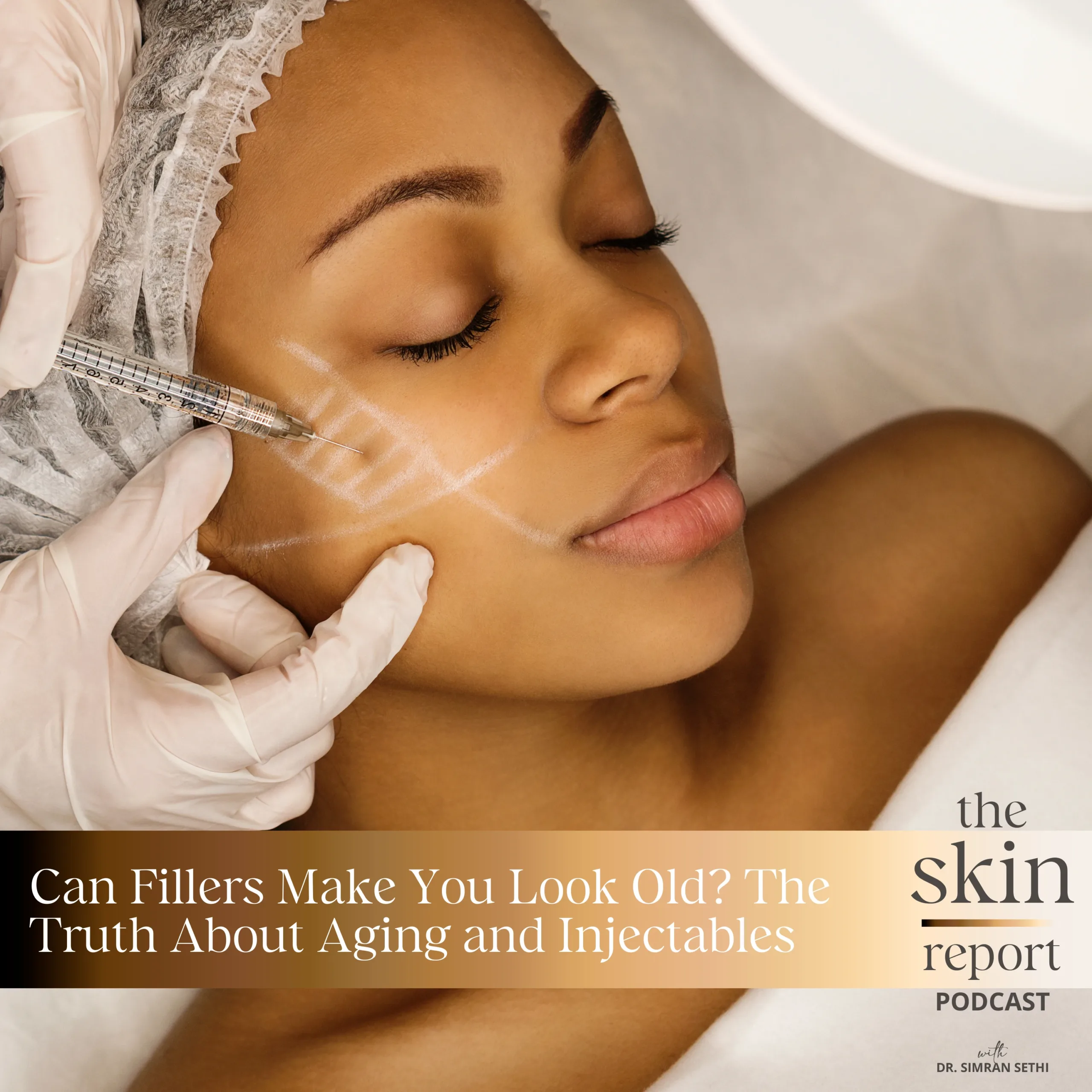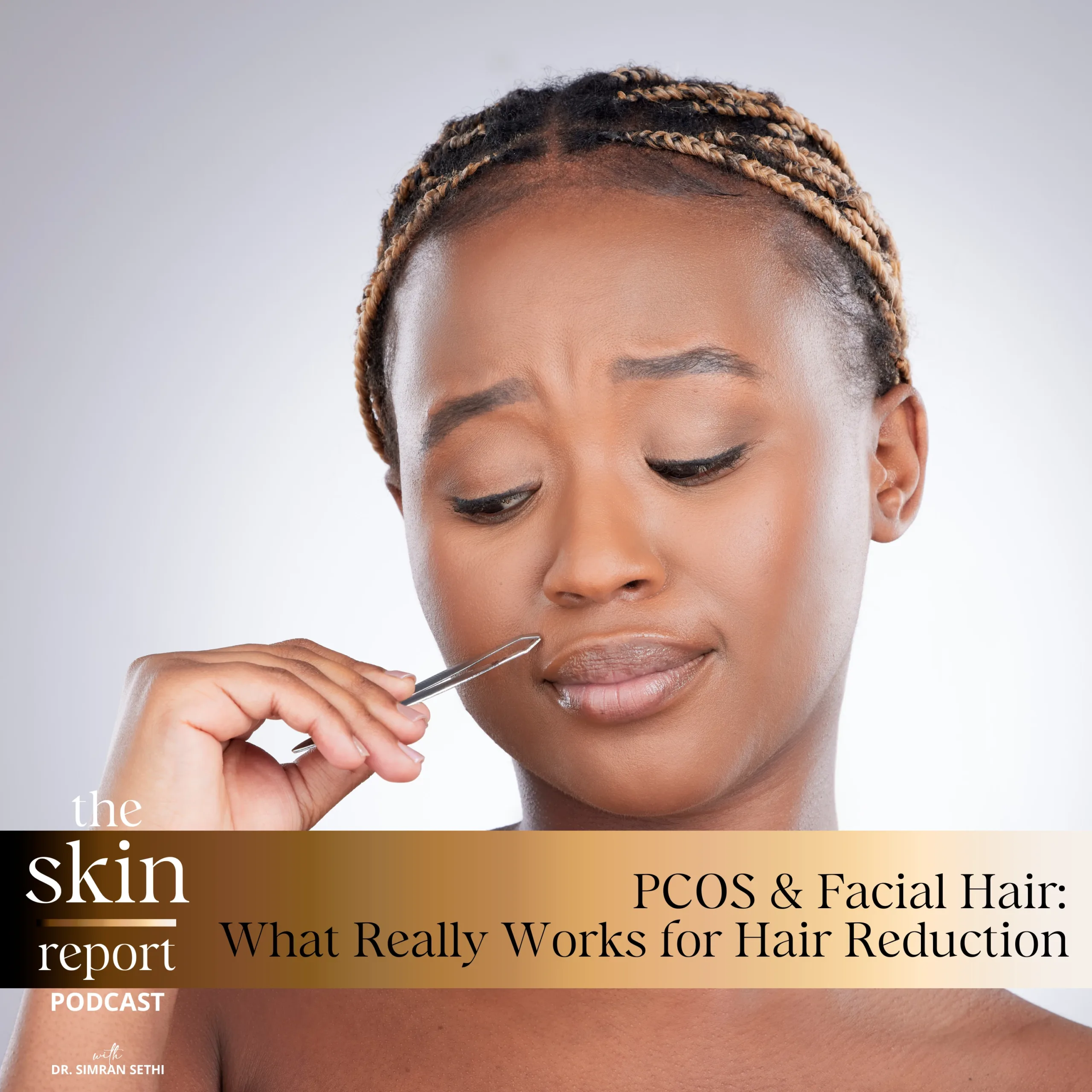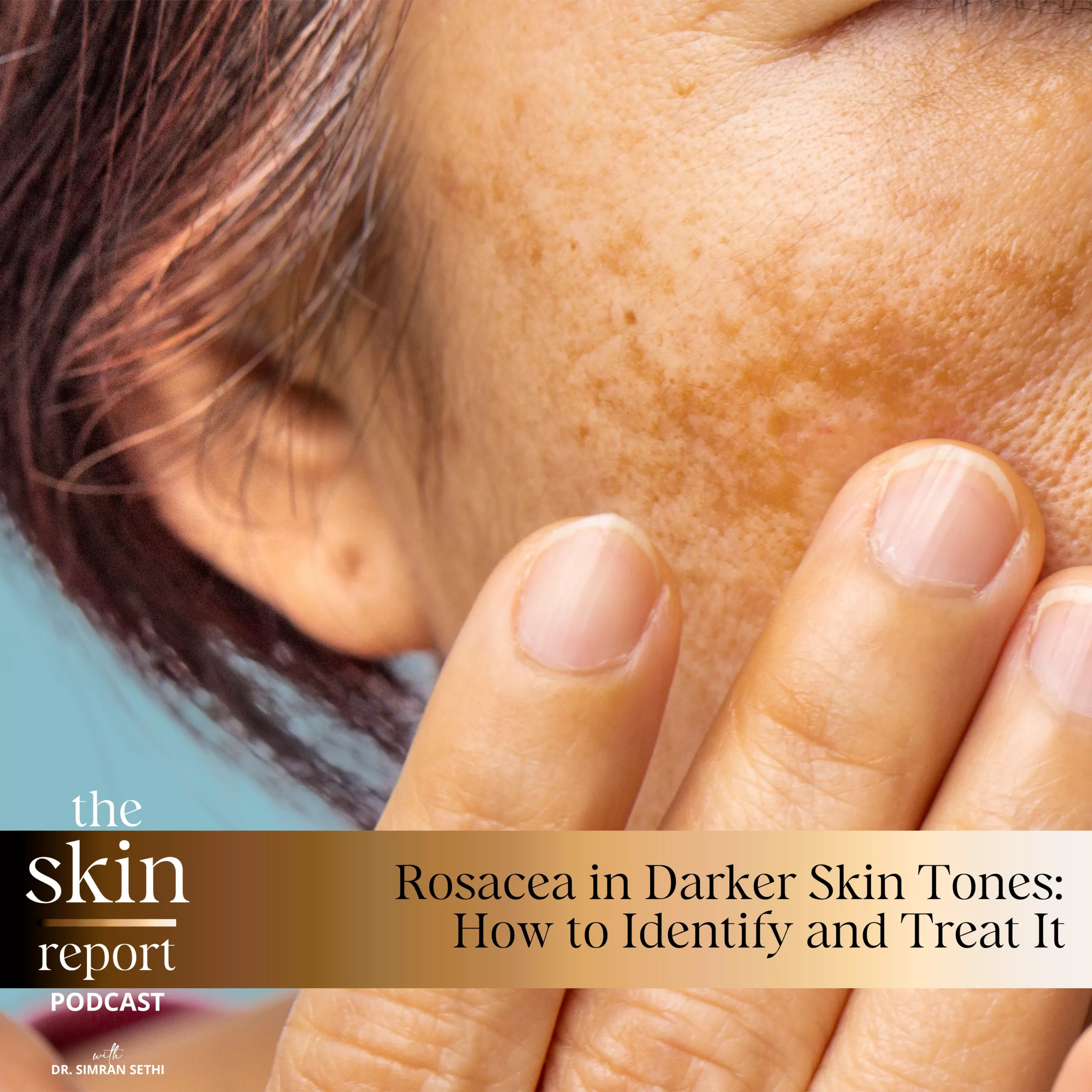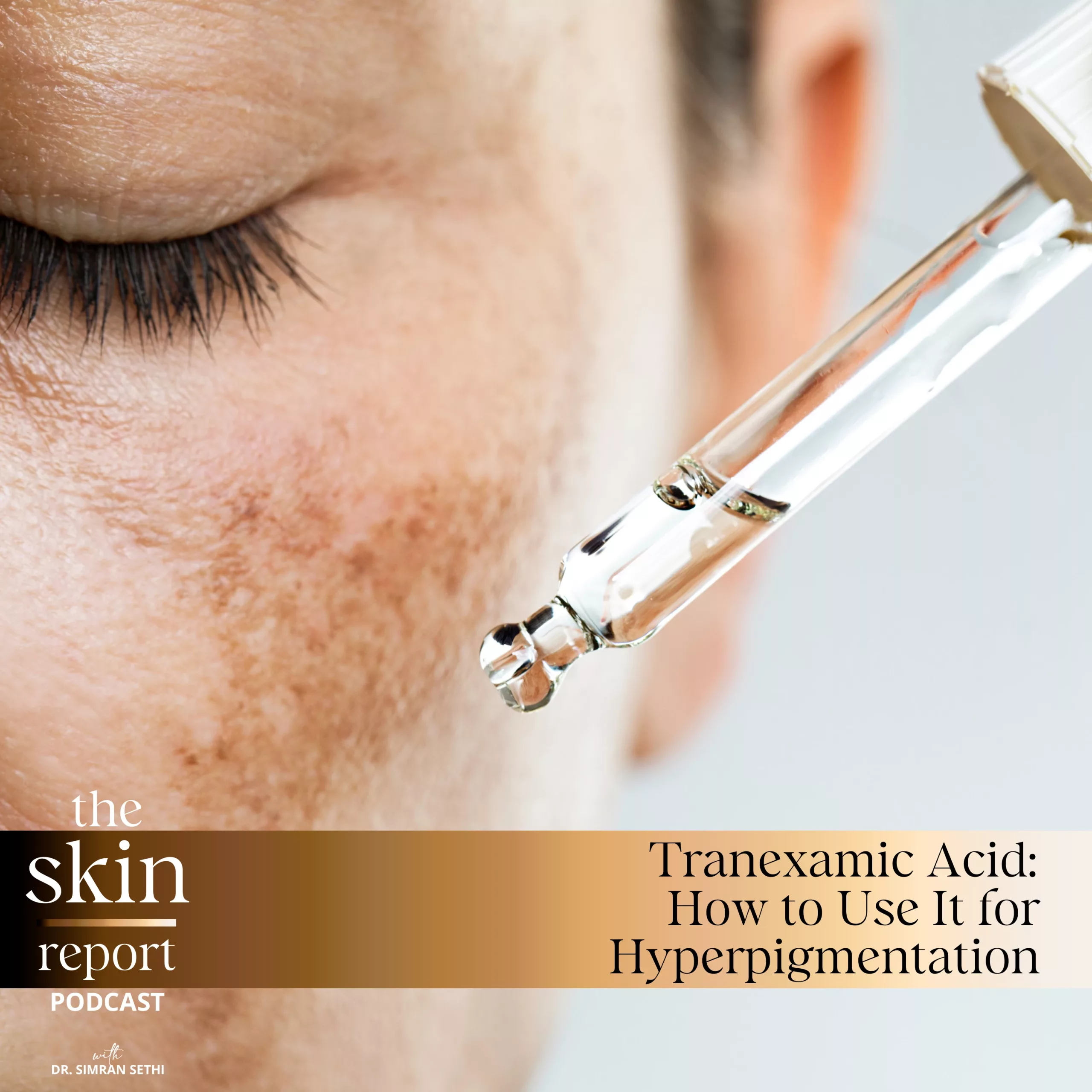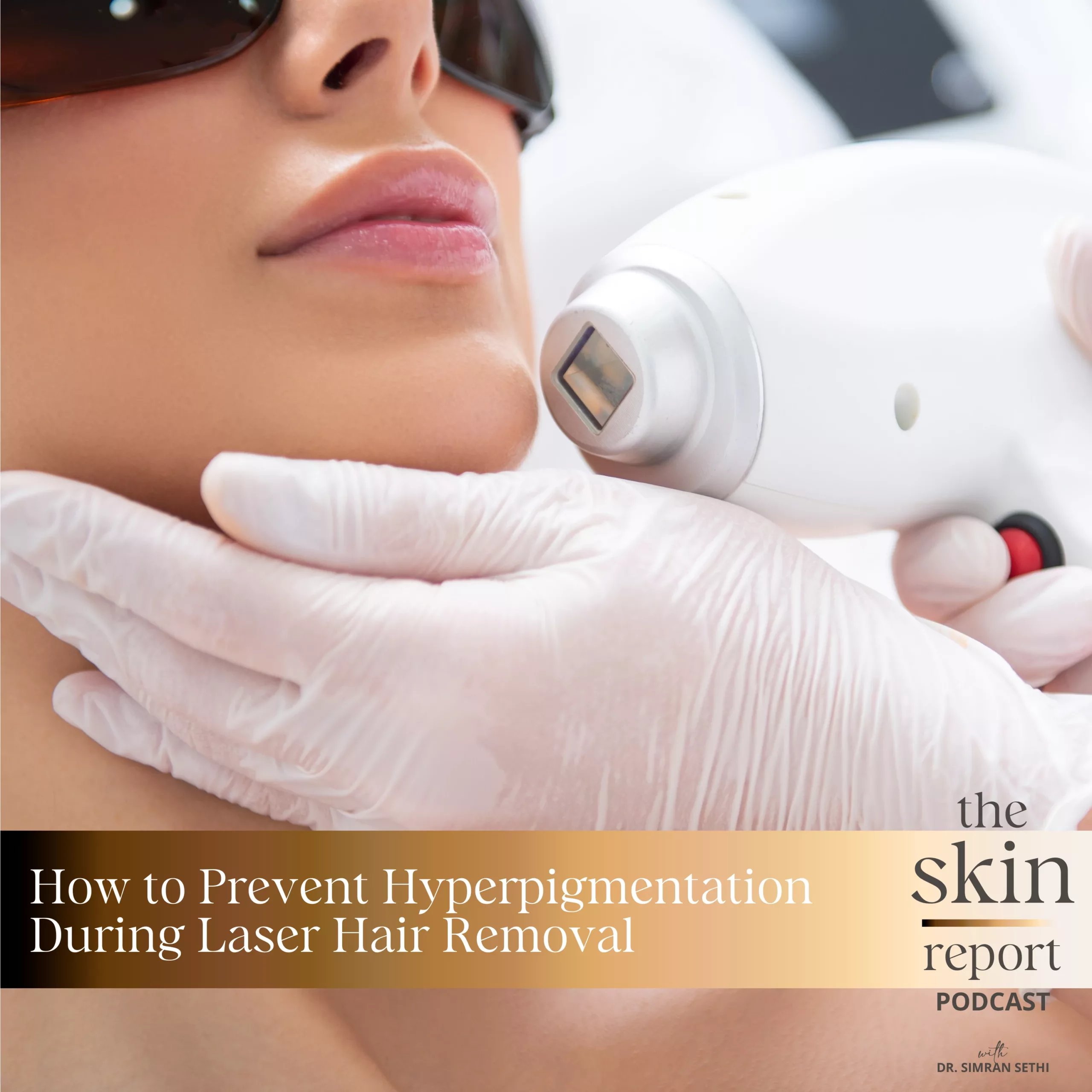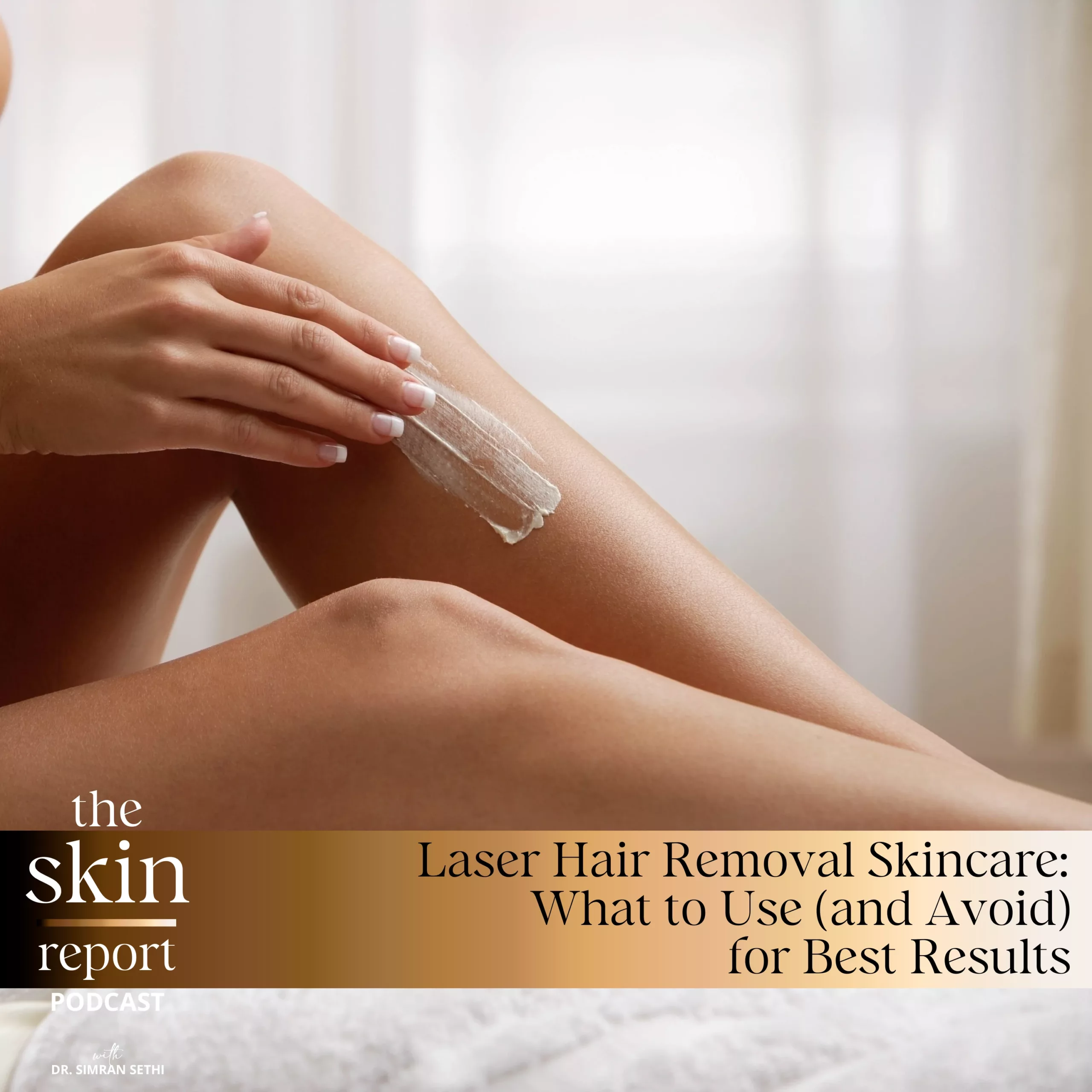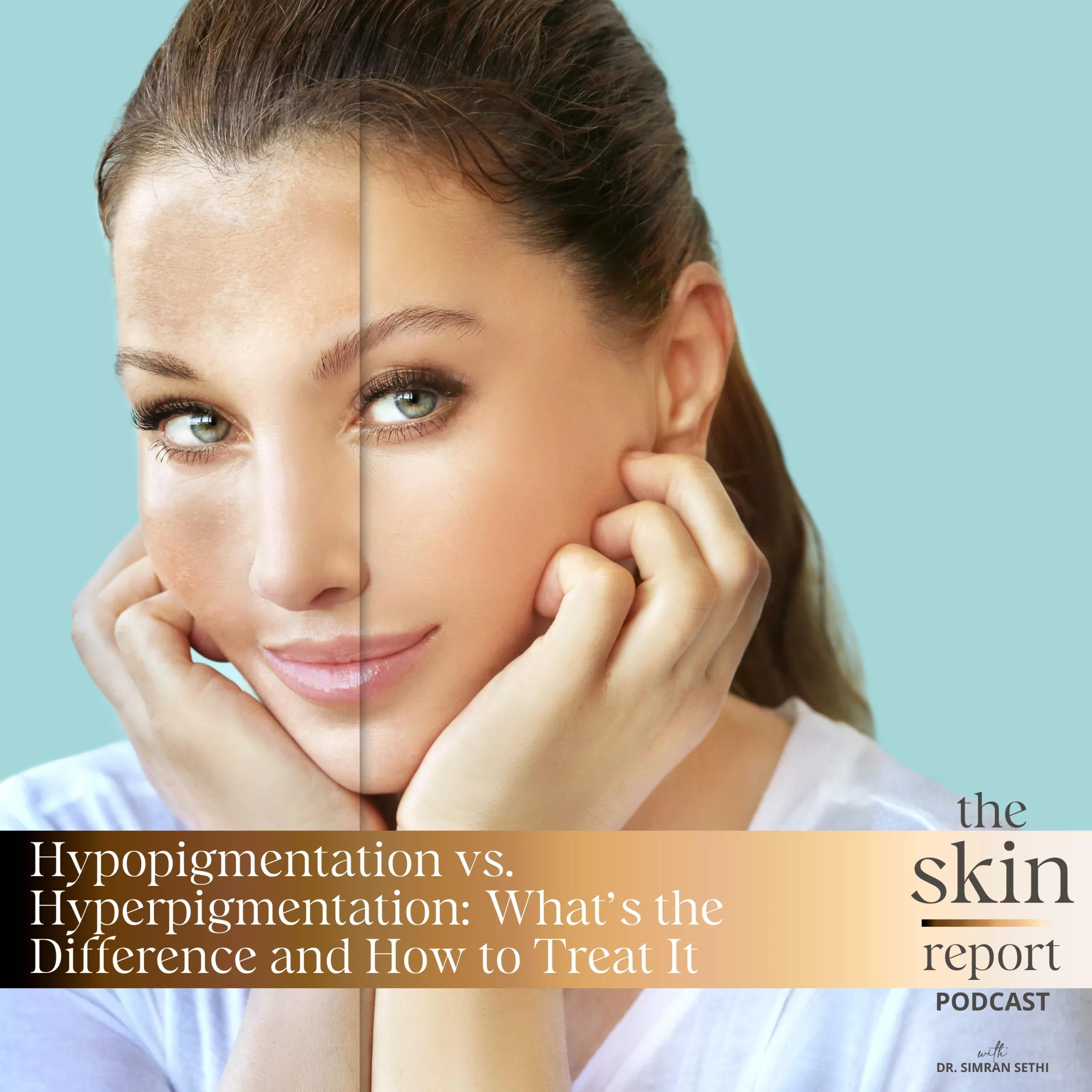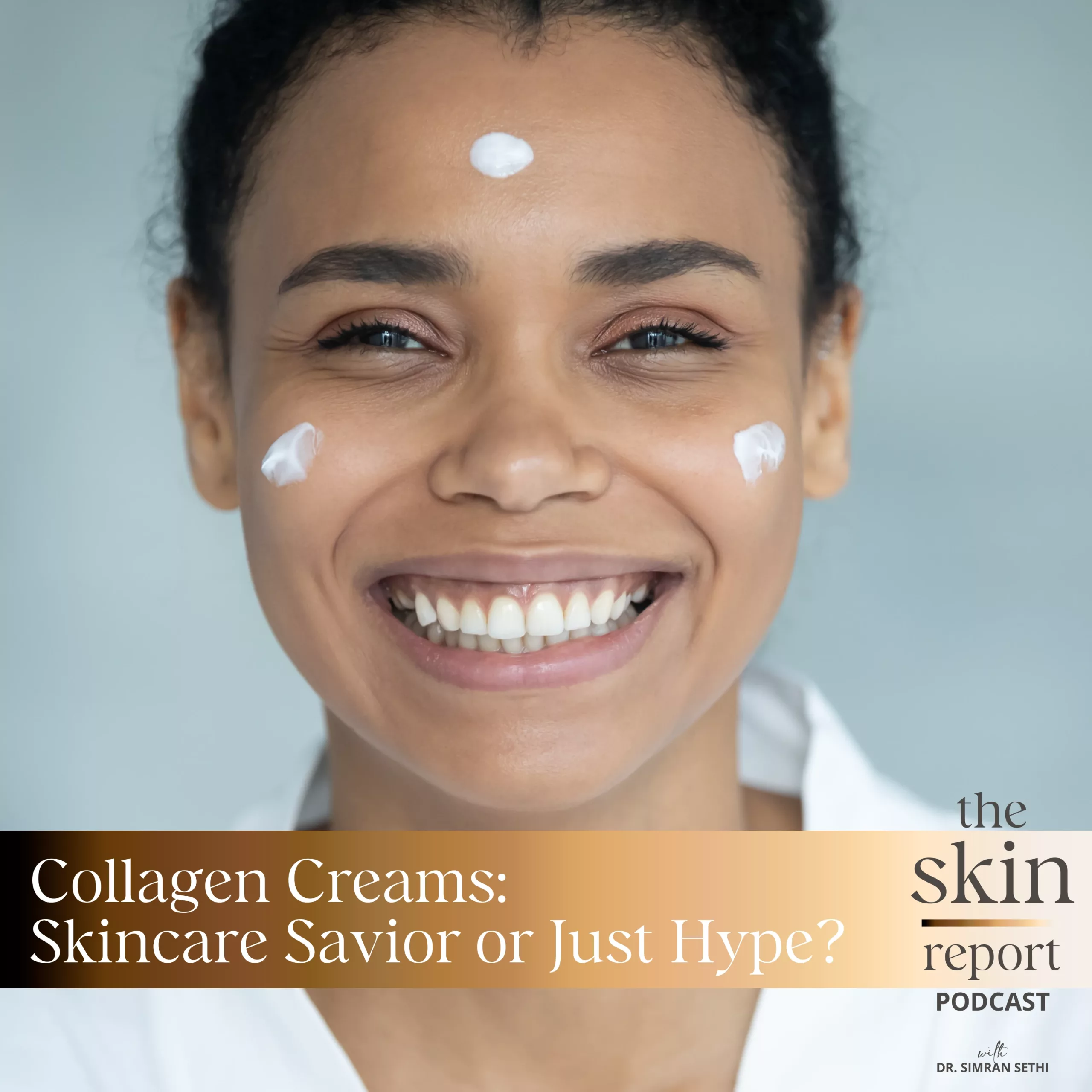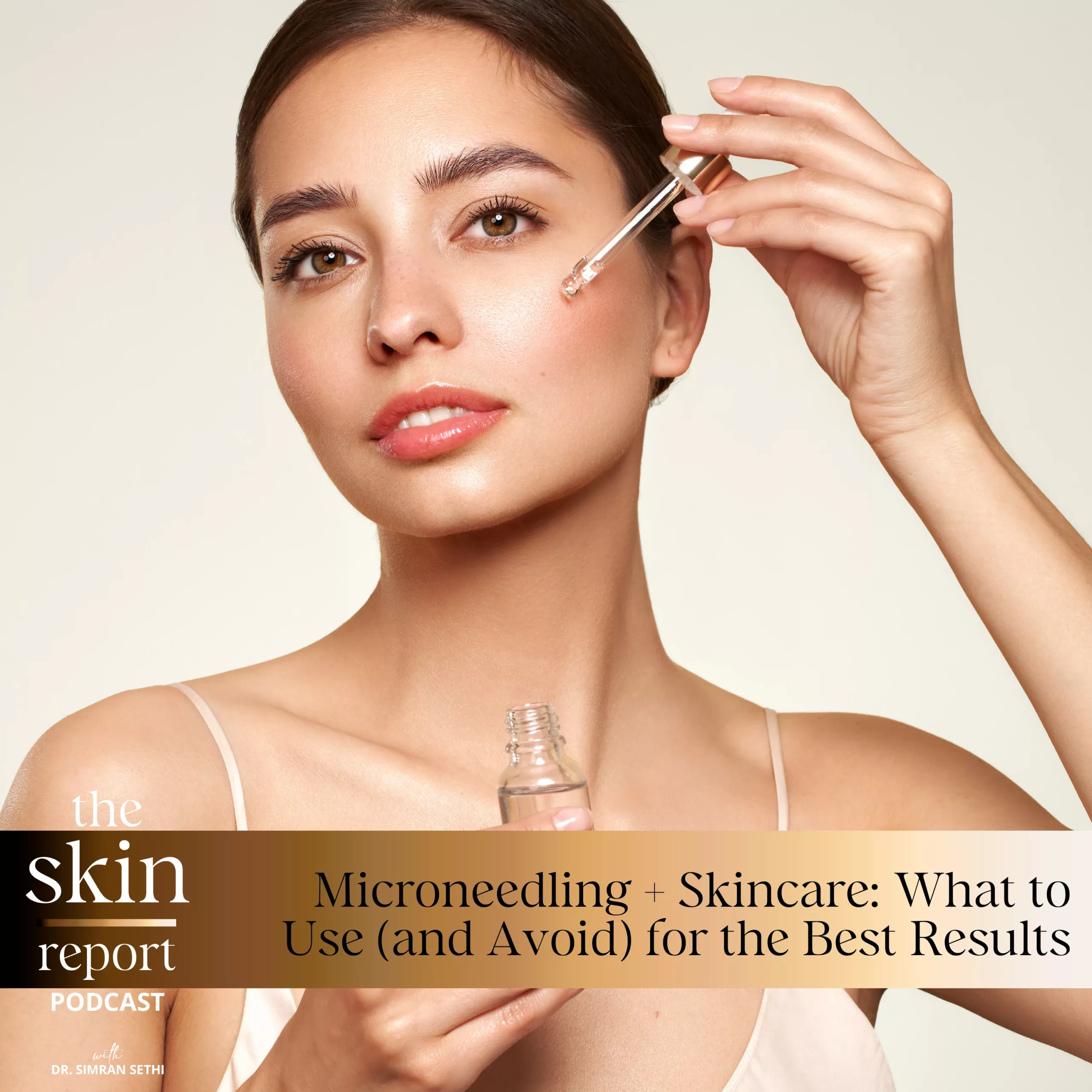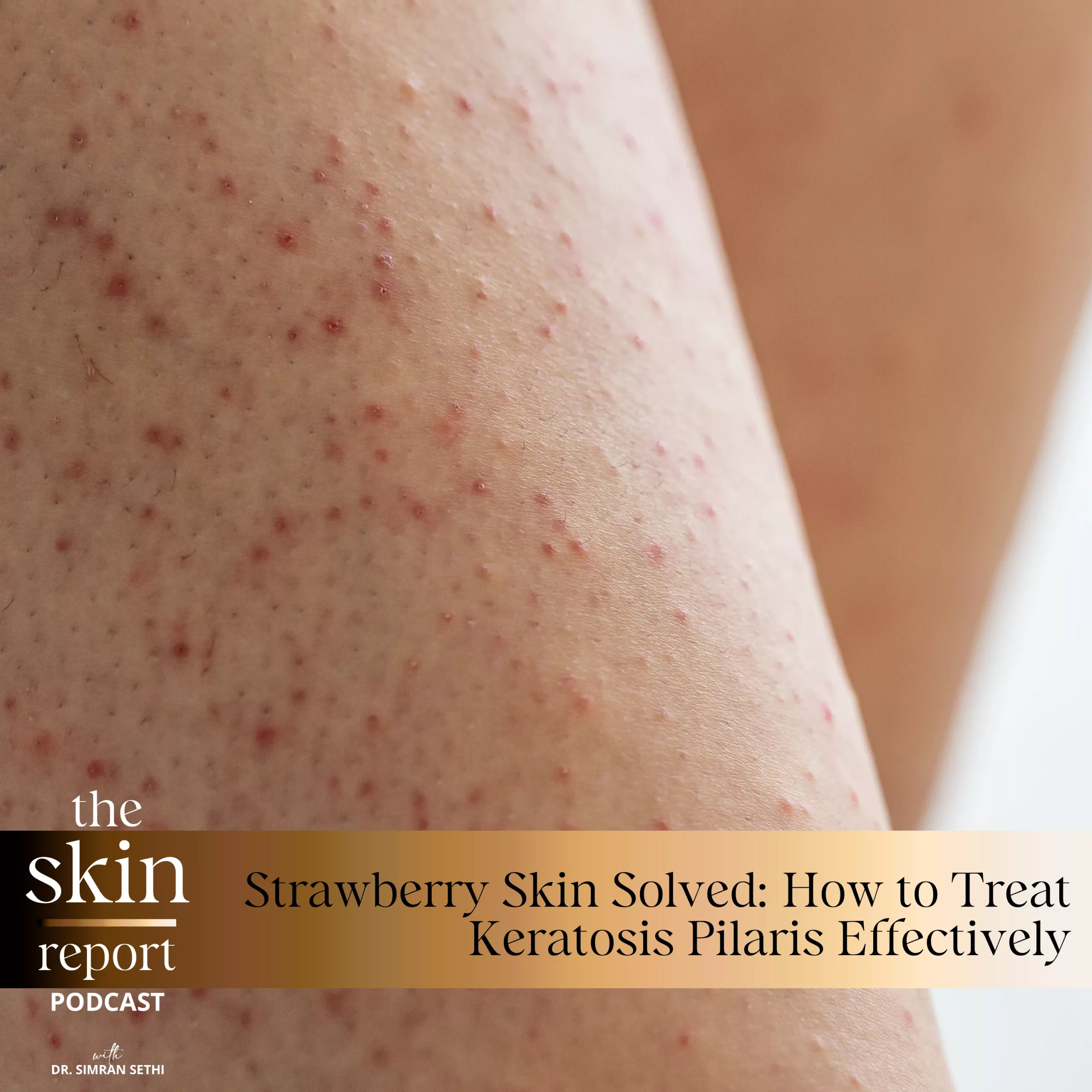This podcast episode will cover a sensitive and controversial topic: skin lightening. Listener discretion is advised, as the episode will surround subjects like colonization, racism and colorism. Follow along to learn about the history and harm of certain skin-lightening practices and how today’s safe skin-brightening alternatives are instead used to treat scarring, acne, and UV damage.
The Skin Report is a podcast created to educate listeners on methods to improve skin health for people of all ethnicities and ages. On this episode, host Dr. Sethi breaks down the dark history of skin-lightening practices and how today’s alternatives can brighten the skin for improved skin health. Dr. Sethi addresses colonialism and the colorist ideals that led to damaging skin-lightening practices of the past like harmful creams and skin bleaching. Finally, she also explains how today’s skin-brightening methods safely lighten the skin to treat pigment and improve overall skin health.
Follow and DM a question for Dr. Sethi to answer on The Skin Report Podcast:
Renew Beauty Instagram:
https://www.instagram.com/renewmd_beauty/
RenewMD Beauty Medical Spas, California:
https://renewmdwellness.com/
The Skin Report Season 1 Episode 2: How Melanin Impacts Your Skincare:
https://theskinreportbydrsethi.com/s1e2-how-melanin-impacts-your-skincare/
This transcript was exported on April 11, 2023 -view latest version here.
Skincare can sometimes feel overwhelming, whether it’s finding the right products, ingredients, or treatments. There’s a lot out there, but not always for people of African, Hispanic, middle Eastern and Eastern South Asian descent. That’s why I set out to educate myself and others so that we can all feel beautiful in our skin. Hello and welcome back to The Skin Report. I’m Dr. Simran Sethi, an internal medicine doctor, mom of three and CEO and founder of RenewMD Medical Spas and Skin by Dr. Sethi. Today’s episode and next week will bring up a sensitive, controversial topic. I say this to give you a content warning. Our discourse will surround subjects like colonization and its consequences. The truth of the matter is that racism and colorism cannot be fully separated from today’s skincare topic, skin lightning. If this is triggering to you, please do what you need to do to care for yourself, even if that means clicking away. However, if you are interested in taking a bite out of this massive topic, follow along as I cover the history and harm of certain skin lightning practices as well as safe alternatives to treat UV damage and acne that don’t drastically change your skin tone, but rather clarify marks. Without further ado, let’s jump right in.
We can’t talk about skin lightning without first addressing colonialism and the western world. Most countries only gained independence from the British relatively recently. Like India, for example, in 1947 or Fiji in 1970. But the effects of colonization are still felt today in racism and colorism. These are complex topics and many history podcasts do a great job picking apart their intricacies. For the purpose of our podcast discussing skin lightning, I want to point out that colonization is pervasive and is closely tied to the beauty industry and social standards. As a result lighter skin, typically skin type one through three on the Fitzpatrick scale are more socially desirable. The lighter someone was compared to their peers, the closer to white they were and given more respect and opportunities and the more beautiful they were deemed.
Thus, those with darker skin tones face prejudice from both outside and within their own ethnicities. This phenomena is known as colorism and is a legacy of history still present in products that push women of skin types four through six to lighten their skin. For example, the skin lighting cream known as fair and lovely was introduced to the Indian market in 1975 before seeing widespread popularity. Only in 2020 did the cream change its name to glow and lovely. Here I wanted to say that we do not judge on this show with a long history of racism, social pressures and beauty standards it’s no wonder so many women turn to unsafe measures such as bleach to lighten their skin when the end results could be a better life. In season one episode two, we actually discuss skin bleaching and its hazards. If you’d like to learn more, I highly recommend checking that out.
Let’s bring the conversation up to today. I want to acknowledge that skin bleaching is still prevalent in many countries and that colorism should be taken seriously. However, I’d also like to say that there are other reasons a person may want to lighten their skin such as to combat scarring and UV damage. In fact, I’ve encountered thousands who are not ashamed of their ethnicity or race, however brightening their skin would help address issues they’re currently struggling with. I would like to look at safe skin lighting methods that can be used to treat pigment and brighten the skin and overall improved skin health. I want to speak on skin lighting injections, which sounds much scarier than it is. These injections are actually IVs of glutathione, a strong antioxidant that reduces the production of eumelanin, a type of melanin. Now, what does this mean? In order to understand glutathione and its effects on skin color let’s first discuss what gives the skin its color.
In the skin there are two kinds of melanin which every person has the ability to produce regardless of ethnicity. The two kinds of melanin are eumelanin, which is a brown, black pigment. And pheomelanin, a yellow, red pigment. Our skin color comes from the ratio of eumelanin and pheomelanin. That means someone with skin type four or five has a greater amount of eumelanin than pheomelanin, while someone with skin type one or two has more pheomelanin than eumelanin. These two types also have different reactions to the sun. Eumelanin absorbs UV radiation, damaging free radicals and oxidative stress, which gives darker skin tones protection from skin cancer and skin aging. Pheomelanin however absorbs UV radiation and instead produces free radicals, which frequently leads to carcinogenesis. The difference in people’s pigmentation comes down to their ratio of eumelanin and pheomelanin and the amount of melanin their melanocytes can create. Researchers widely believe that melanin production in melanocytes increase as an evolutionary adaptation to the widespread loss of human body hair more than a million years ago. Populations living closer to the equator tended to develop a greater proportion of eumelanin, which is a UV absorbent, antioxidant and free radical scavenger. Conversely, populations living further from the equator are relatively richer in pheomelanin, which produces free radicals in response to UV radiation accelerating carcinogenesis.
As UV light exposure is the main stimulus for vitamin D production in the skin, it stands that dark-skinned individuals also tend to have lower levels of vitamin D and should be screened accordingly. How does this relate to glutathione and IV skin lightning injections? Glutathione is a strong antioxidant that is naturally found in the liver and is a byproduct of cellular metabolism. It has been found to essentially redirect production of eumelanininto pheomelanin. There’s an enzyme called tyrosinase that converts a protein called L-Tyrosine to another molecule called dopaquinone. Dopaquinone goes through various pathways to either make pheomelanin, the yellow red melanin, or eumelanin. This is where glutathione comes in. Glutathione can attach to dopaquinone to lead it into making more pheomelanin instead of eumelanin. The increased production of pheomelanin instead of eumelanin results in an overall lighter skin tone. By increasing glutathione levels, there will be an increase in pheomelanin levels.
Increasing glutathione levels in the body requires time and patience as it is not something you can deliver to the body in one shot but have to do it gradually. Our body’s like a sponge, so if you saturate it too much with glutathione, it’ll just waste it through the kidneys. Instead in my practice where we deliver a lot of skin lightning injections for thousands of patients, I put them through a series of 15 to 30 injections spaced a week or few days apart in between injections. This allows glutathione levels to gradually build up in the body and up regulate the production of pheomelanin. Lightning the skin isn’t always a true end goal of IV glutathione, skin health is. Studies have repeatedly shown that glutathione reduces acne breakouts, improves skin elasticity and reduces wrinkles. Glutathione is an antioxidant, which means it fights free radical damage, which then leads to healthier skin. Now, I know we must all address a big question. How light willmy skin get? More on that when we return.
IV skin lightning with glutathione has been a popular treatment at east and South Asia, mainly in the Philippines and India. Most studies relating to this therapy come from [inaudible 00:08:47]. Remember, IV skin lightning redirects myogenesis from predominantly making eumelanin to feel pheomelanin instead, so those who see the most results have a greater ratio of eumelanin or darker brown pigment to start with. Many people ask, how many shades lighter will my skin get? This is very difficult to predict and varies amongst each person. In general, after about 13 weekly injections, patient’s skin appears brighter and yes, lighter as well. This level of lightness is really what their skin would do if they were to limit their sun exposure significantly. In essence, your skin will not appear unnatural.
It will be similar to the natural variation we may see when spending an entire summer outdoors or an entire winter indoors. You will not look like you’ve changed your race.I know that a lot of people remember the late Michael Jackson completely lightning his skin to almost not having any pigmentation. This was not done with glutathione and this level of skin lightning is not achievable with glutathione either. Michael Jackson received a type of chemotherapy that permanently destroys melanocytes. This treatment is an option for people suffering from a demyelinatiion disease called vitiligo, and is completely different from glutathione therapy. IV glutathione does not destroy melanocytes. It simply shifts production away from a darker melanin to a red, yellow melanin. A common misconception that people have about IV skin lightning is that it is performed to make one look radically different and that it propagates a colonial mindset that lighter skin tones are more attractive.
This is far from the truth, and I say this because I’ve met thousands of men and women in my practices who get IV glutathione treatments to optimize their skin health and usually reverse sun damage. I feel that there’s a lot of judgment associated with skin lightning, and that is something I absolutely don’t support. IV skin lightning treatments are just skin enhancements similar to highlighting your hair or a fair-skinned person going and getting tanned, but the difference is that IV treatments are good for you and your health. In my years of experience, people are not trying to change their identity or race, but rather find another way to reverse UV damage, acne and skin aging.
Now, what are the risks? As I said, glutathione is an antioxidant and it’s very safe. However, because these injections are common in the Philippines and India, most of the adverse effects data comes from there. There’s always a chance of infection when injecting something into the body. At all times, sterile needles and infusion tubing should be used and the glutathione should be sourced from a reputable pharmacy. In the United States, glutathione can only be acquired from strictly regulated compounding pharmacies by physicians. This is why IV glutathione injections are only offered at physician offices. If you see these IVs being offered anywhere else, steer away. Only a licensed professional, which means physicians’ office, in the United States can deliver IV injections. The injection is given by a registered nurse and should not be given by anyone without a RN license. Next, it’s very difficult to overdose on glutathione, but studies from India or the Philippines show it rarely does happen. As our bodies are like a sponge. Any excess glutathione not absorbed will be filtered out through the kidneys.
Some studies have shown that this will increase the chances of forming a kidney stone. However, this happens at very, very high doses of IV glutathione which are not used in the United States if clinical protocols are followed. Glutathione is very safe and is used regularly for other medical situations such as treatment of neurotoxicity after chemotherapy, alcoholic fatty liver and liver cirrhosis. So what is the experience of getting IV glutathione injections? When you come into my practice for a skin lighting treatment, you will receive a mix of antioxidants. I give 15 to 30 injections of 2000 milligrams of IV glutathione and 2000 milligrams of IV vitamin C infused over five minutes weekly. Or two times a week if the patient has enough time to come in that frequently. There is no need for a drip IV bag that you sit with for 30 minutes as that is just a mixture of the same antioxidants with one liter of normal saline for hydration.
I have added vitamin C to the IV as it is another strong antioxidant that promotes skin and overall health and has been proven to reverse UV damage as well. Vitamin C does not can convert dark brown melanin formation to more pheomelanin formation, but it reduces UVoxidative damage to reduce production of excess pigmentation. However, I use IV glutathione in my practice for several other reasons. Another reason is acne suppression. The exact mechanism of acne suppression with glutathione is not known and has minimal clinical data to support it, so I can only say this anecdotally. I have repeatedly seen people with moderate to severe acne see drastic improvement in their breakouts with IV glutathione. I don’t use this as a first option, but if someone is considering IV glutathione treatments and has acne, I do tell them that this would help suppress their breakouts. The next reason would be for health and detoxification.
Glutathione and vitamin C are undeniably excellent antioxidants that can detoxify the liver and kidneys. These antioxidants are used after certain kinds of toxic chemotherapy regimens in the healthcare setting to replenish liver and kidney health. If you are a listener, you know that I’m a huge fan of skin treatments like microneedling and PicoSure laser, and sometimes depending on the scenario, we’ll add on IV skin brightening to these treatment as an adjective therapy. If a patient has severe to moderate acne and wants reduction of acne scars. Combining microneedling treatments with IV glutathione and vitamin C, we’ll give beautiful results and suppress breakouts. Even in scenarios where we are correcting excess pigmentation from long-term UV damage, combining therapies gives more superior results faster. The reason this combination works so well is because all skin treatments are really a controlled injury to the skin to trigger a new skin and collagen building response.
By adding high doses of antioxidants to your body, you are feeding the skin building response and enhancing the results. Now, you may be wondering if these injections can be used for melasma. This is questionable and something that I cannot find any scientific evidence for. Melasma is a combination of new pigmentation and old pigmentation. While I don’t see the harm in doing my go-to melasma treatment PicoSure laser at the same time as IV glutathione and vitamin C therapy, I cannot say with confidence that there is much greater improvement in results.
Thank you so much for listening to today’s episode. I know it was a complex one. No matter your previous stance on skin lightning, I hope you were able to take away something new from the show. Next week, I’ll be covering some popular lightning and brightening products and whether they’re safe, if they’ll help to calm melanin production, or if they’ll aggravate it. Thanks for listening, and until next time, love the skin you’re in and celebrate your beauty. If you’d like to learn more about science backed skincare or medical aesthetic treatments, please subscribe to and turn on notifications for The Skin Report so you always know when a new episode is up. We have a newsletter that you can sign up for on theskinreportbydrsethi.com so that you can stay up to date on all our new episodes, blogs, products, and more. Additionally, if you have a skincare question or want to make an episode topic recommendation, please message me at theskinreportbydrsethi.com, which is linked in my show notes, and I’ll be sure to answer your question in an episode soon. We’ve received some great questions so far and I will try and answer them at the end of every episode, so keep them coming.
Transcript by Rev.com


